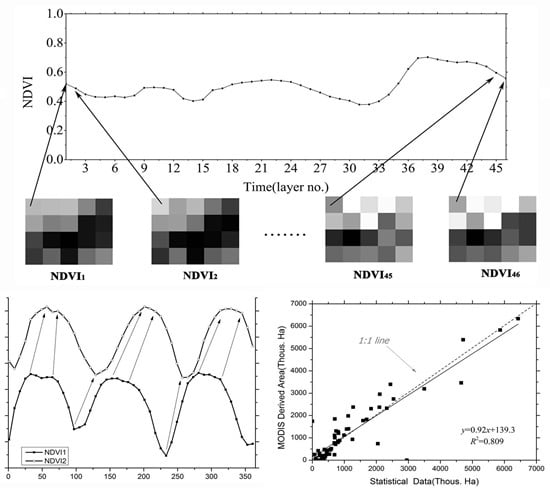Mapping Rice Cropping Systems in Vietnam Using an NDVI-Based Time-Series Similarity Measurement Based on DTW Distance
Abstract
:1. Introduction
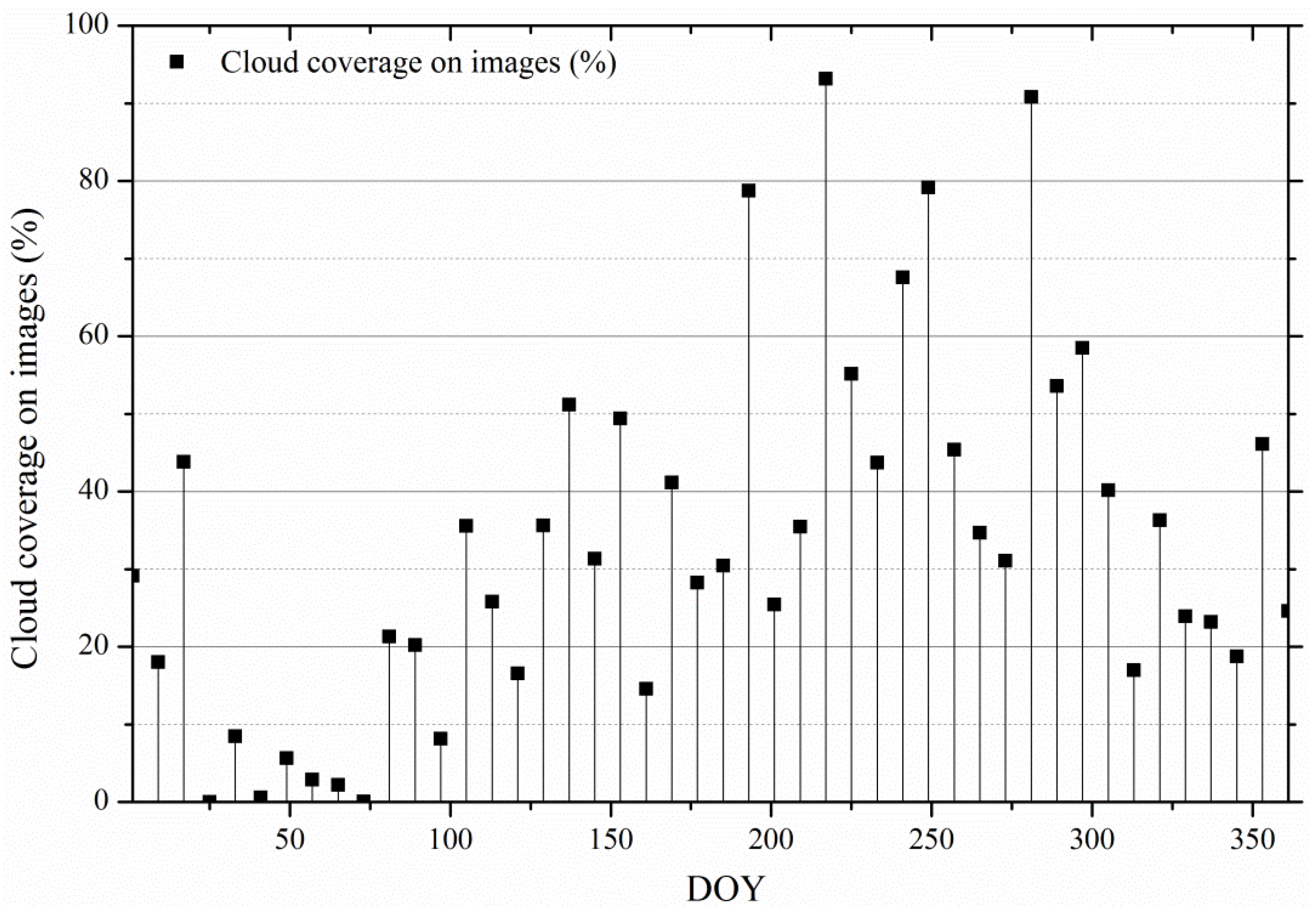
2. Study Area and Materials
2.1. Brief Introduction to the Study Area
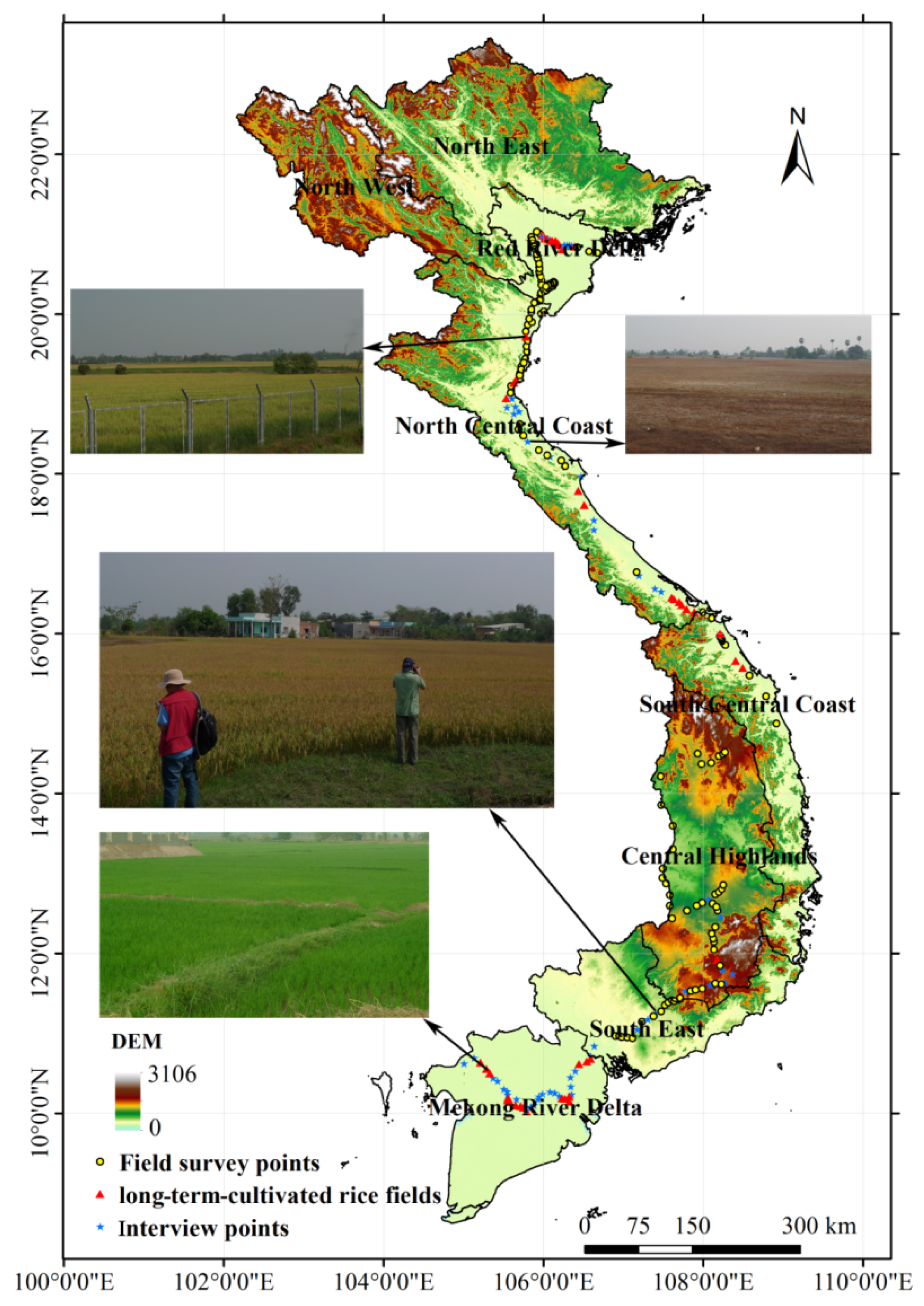
2.2. MODIS NDVI Time-Series Data
2.3. Digital Elevation Model (DEM) Data
2.4. Ancillary Data
3. Data Preprocessing
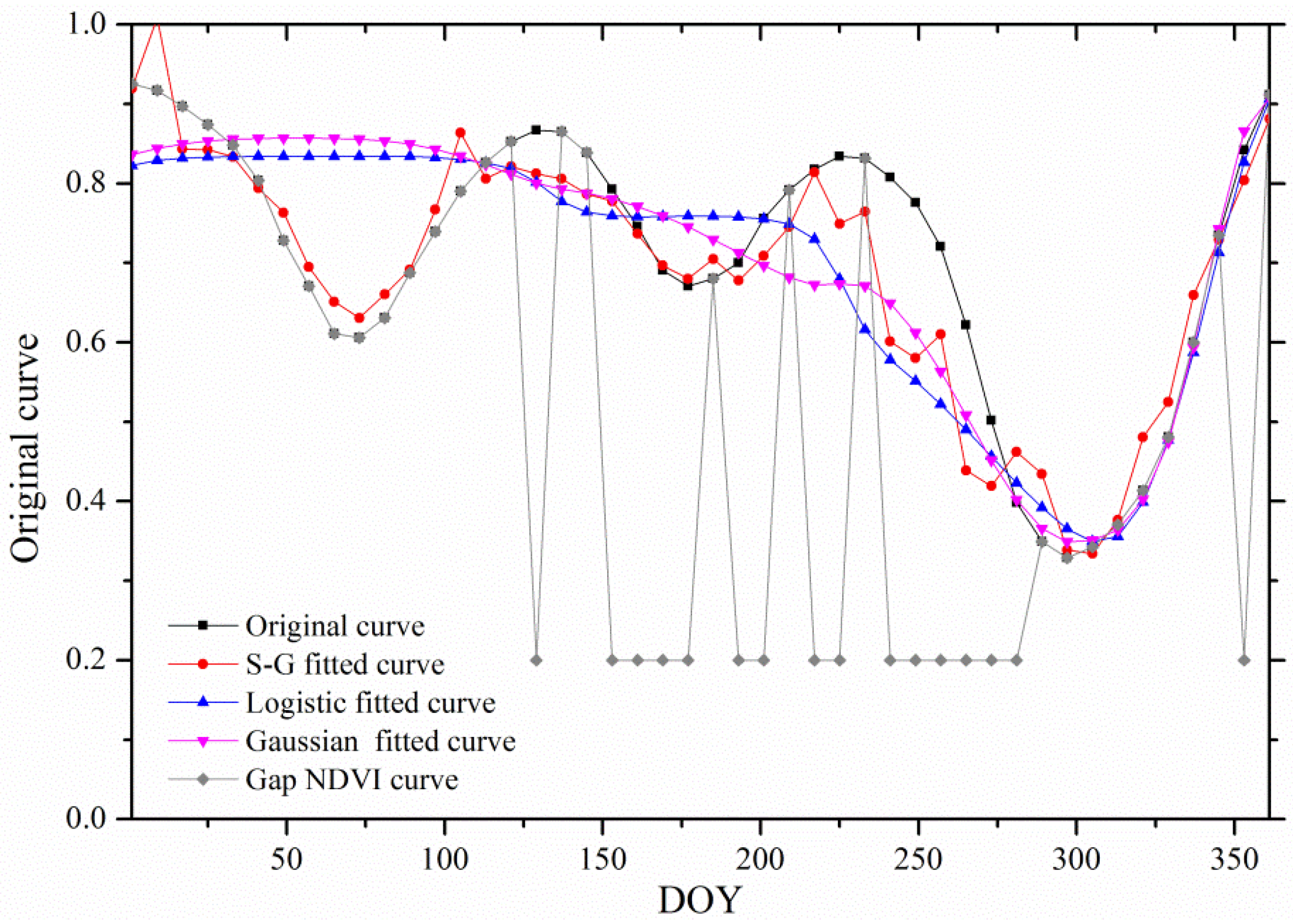
4. Methods
4.1. Building Standard NDVI Time-Series Base
4.2. Dynamic Time Warping Based on Time-Series Similarity Measurements
- Monotonicity constraint: wk = aij, wk+1 = ai’j’, then i’ ≥ i and j’ ≥ j
- Endpoint constraint: w1 = a11, wk = amn
- Continuity constraint: wk = aij, wk+1 = ai’j’; then i’ ≤ i + 1 and j’ ≤ j + 1.
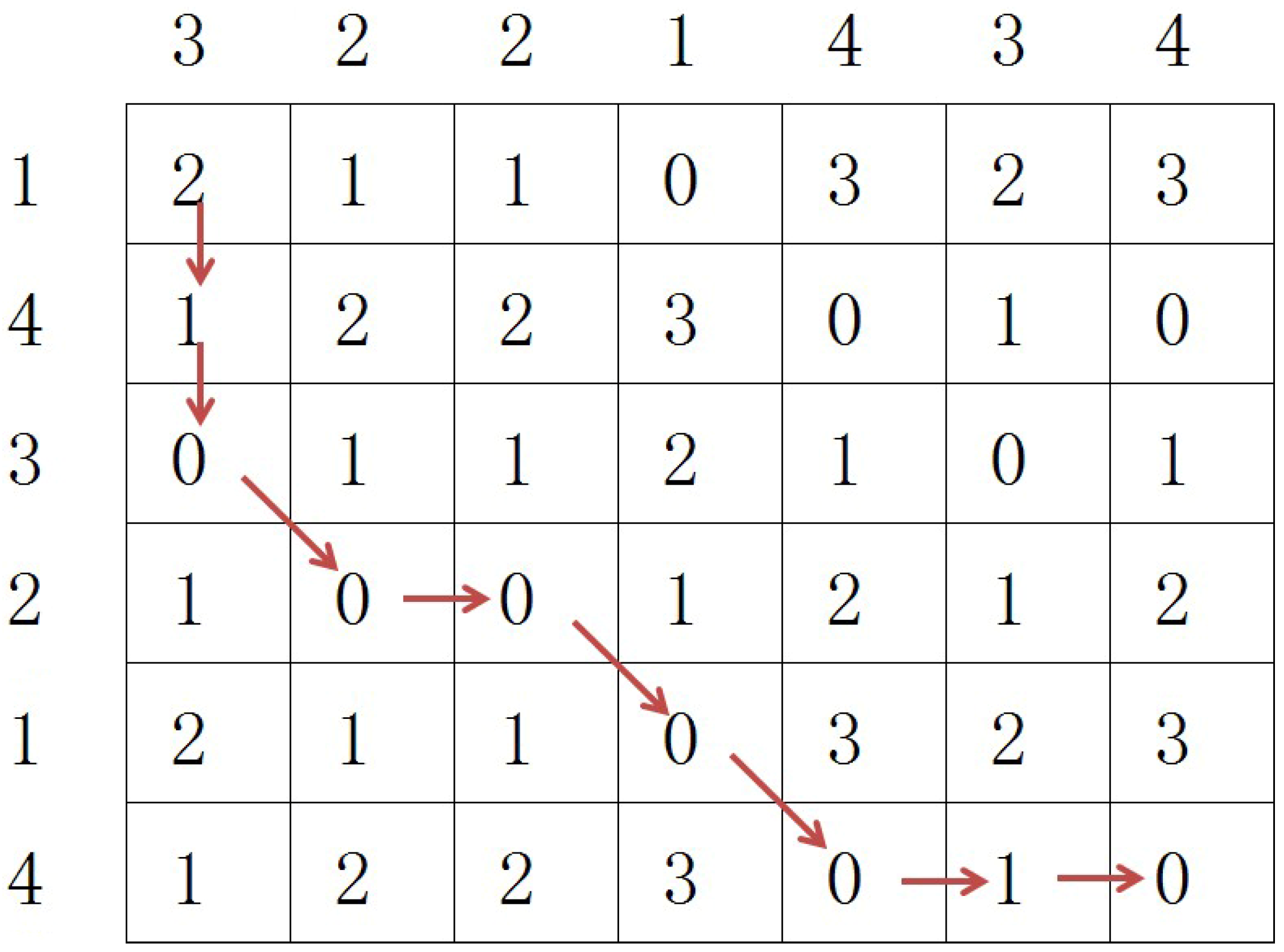
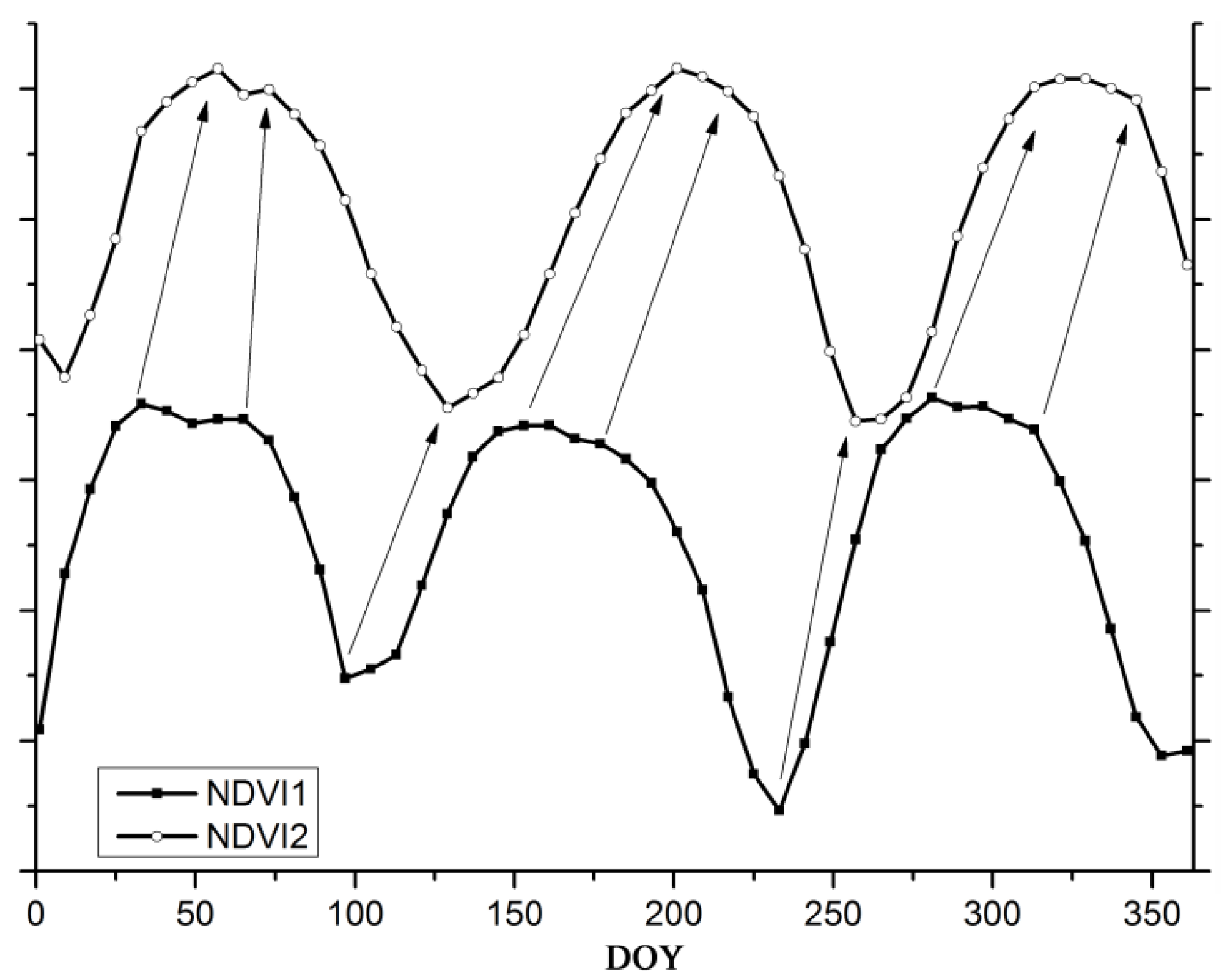
5. Results
5.1. Standard NDVI Time-Series Base and DTW Distance
| Region | Time Series Shape | Time Series Shape | Time Series Shape |
|---|---|---|---|
| North East & Red River Delta |  Irrigated Double Rice Cropping in North East region |  Irrigated Double Rice Cropping in Red River Delta | |
| North West |  Rain-fed Single Rice Cropping |  Irrigated Double Rice Cropping | |
| North Central Coast |  Irrigated Double Rice Cropping |  Irrigated Single Rice Cropping I |  Rain-fed Single Rice Cropping |
| South Central Coast, Central Highlands & South East |  Irrigated Double Rice Cropping |  Irrigated Triple Rice Cropping |  Rain-fed Single Rice Cropping |
| Mekong River Delta |  Irrigated Triple Rice Cropping I |  Irrigated Double Rice Cropping I |  Irrigated Single Rice Cropping |
 Irrigated Double Rice Cropping II |  Irrigated Triple Rice Cropping II |  Irrigated Triple Rice Cropping III |

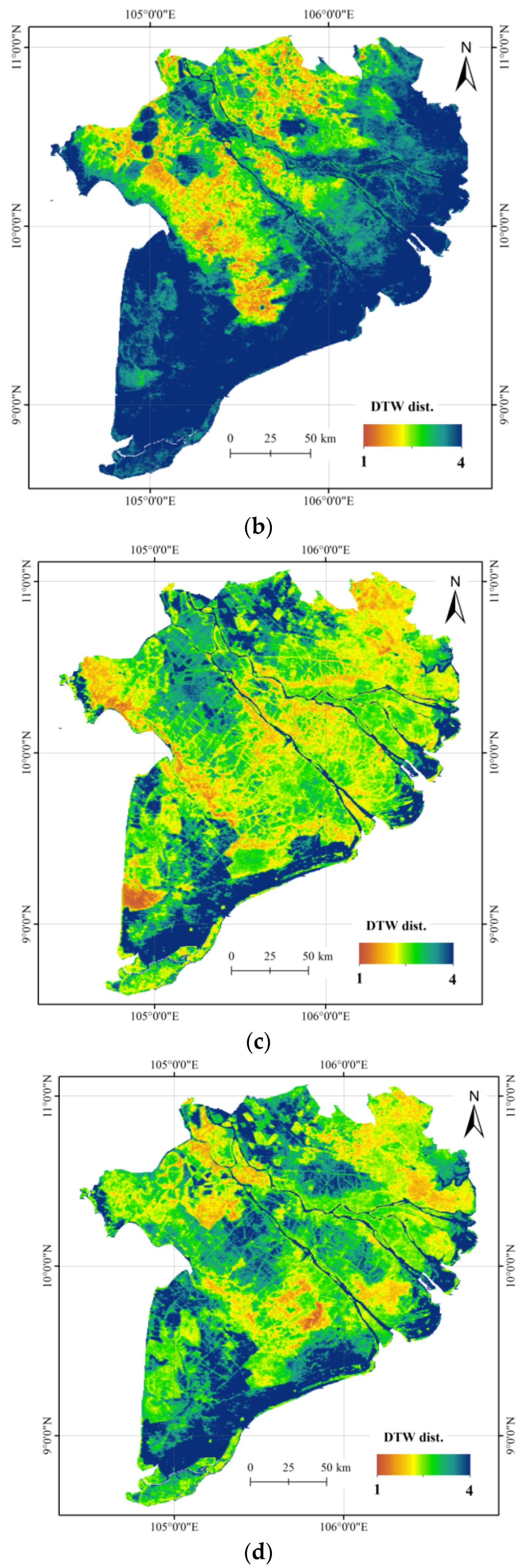

5.2. DTW Threshold and Rice Distribution Map
| North East | North West | Red River Delta | North Central Coast | South Central Coast, Central Highlands & South East | Mekong River Delta | |
|---|---|---|---|---|---|---|
| Single rice | 3.8 | 3.7 | 3.4 | I. 3.3 II. 3.6 | 3.5 | 3.6 |
| Double rice | 3.8 | 4 | 3.4 | 3.7 | 3.6 | I. 3.9 II. 3.4 |
| Triple rice | 3.5 | 3.5 | I. 3.7 II. 3.5 III. 3.2 |

5.3. Accuracy Assessment
| Agriculture District/Province | Statistic Area | MODIS Extracted Area | Agriculture District/Province | Statistic Area | MODIS Extracted Area | ||||||
|---|---|---|---|---|---|---|---|---|---|---|---|
| Total Area | Total Area | Single Rice | Double Rice | Triple Rice | Total Area | Total Area | Single Rice | Double Rice | Triple Rice | ||
| Red River Delta | 11,501 | 15,574 | 165 | 7704.5 | 0 | North East & North West | 6664 | 6241.8 | 1209.7 | 2516 | 0 |
| North Central & South Central (Coastal) | 12,141 | 13,205.1 | 6539.8 | 2116.8 | 479.2 | South East | 1263 | 697.9 | 533.6 | 1.3 | 53.9 |
| Central Highlands | 2178 | 3212.4 | 2982.3 | 101.7 | 8.9 | Mekong River Delta | 39,459 | 40,633.3 | 1315.5 | 8607.8 | 7367.4 |

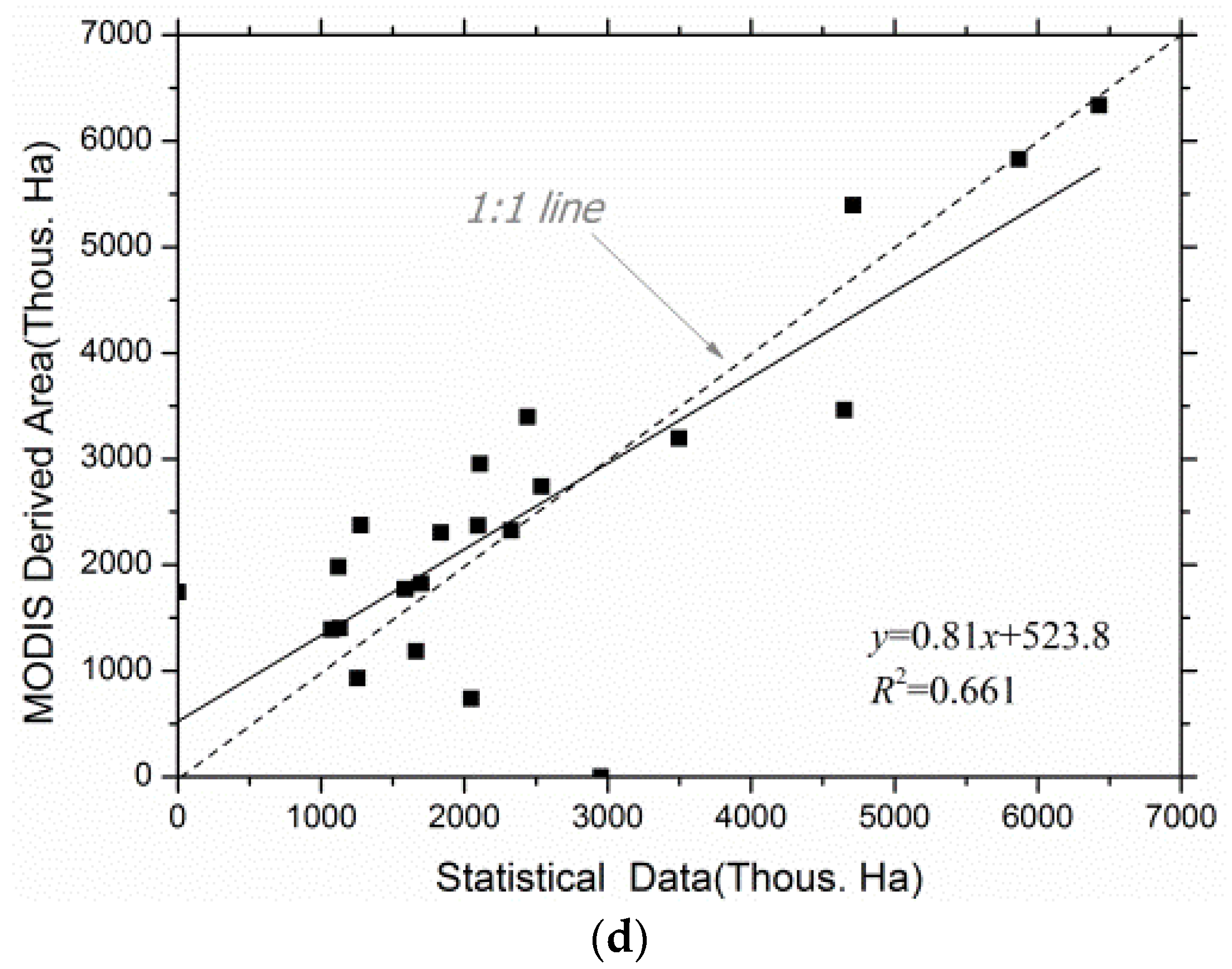
| No. of Field Survey Points | No. of Correctly Classified Rice Points | No. of Rice Points | No. of Correctly Classified Non-Rice Points | No. of Non-Rice Points | Overall Accuracy (%) | Accuracy of Rice Classification (%) | Rice Field Omission Errors (%) | Rice Field Commission Errors (%) | |
|---|---|---|---|---|---|---|---|---|---|
| Entire area | 1200 | 191 | 365 | 708 | 835 | 74.9 | 52.3 | 47.7 | 34.8 |
| First part | 324 | 4 | 26 | 274 | 298 | 85.8 | 15.4 | 84.6 | 92.3 |
| Second part | 391 | 41 | 109 | 237 | 282 | 71.1 | 37.6 | 62.4 | 41.3 |
| Third part | 485 | 146 | 230 | 197 | 255 | 70.7 | 63.5 | 36.5 | 25.2 |
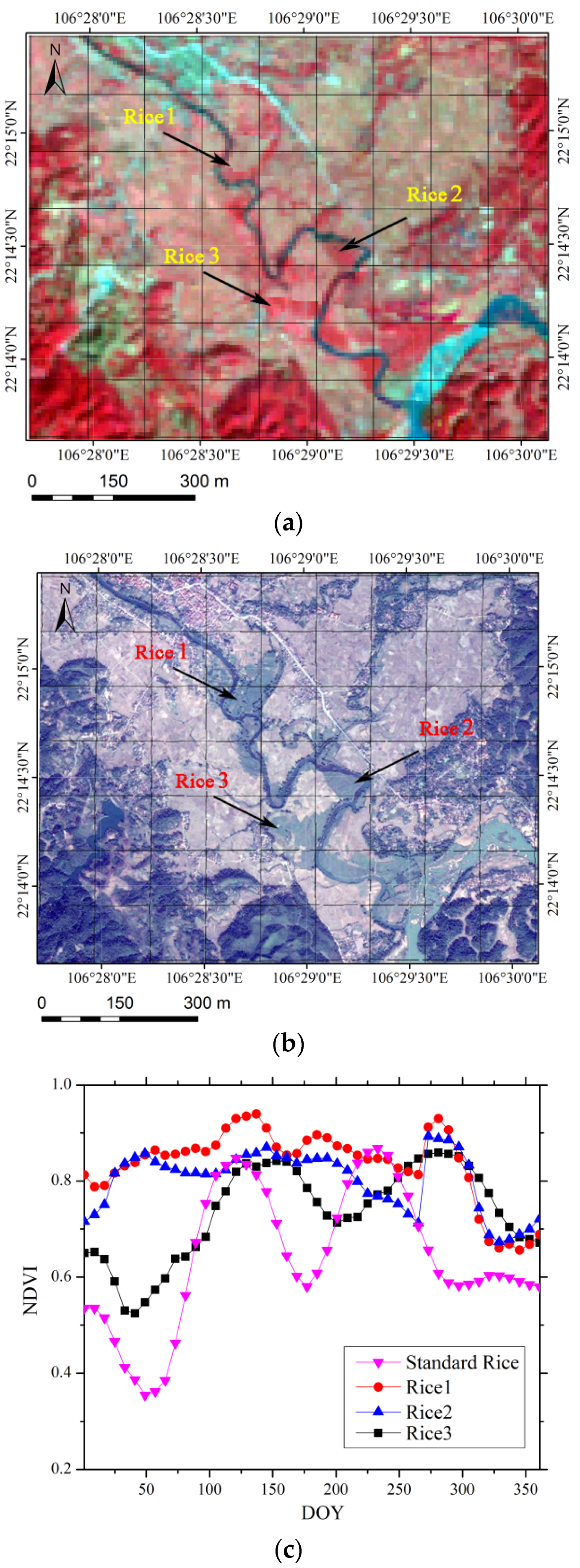


6. Conclusions
Supplementary Files
Supplementary File 1Acknowledgments
Author Contributions
Conflicts of Interest
References
- Fairhurst, T.; Dobermann, A. Rice in the global food supply. World 2002, 502, 454, 349–511, 675. [Google Scholar]
- Kuenzer, C.; Knauer, K. Remote sensing of rice crop areas. Int. J. Remote Sens. 2013, 34, 2101–2139. [Google Scholar] [CrossRef]
- Ricepedia. The Online Authority on Rice: Rice Species. Available online: http://ricepedia.org/ (accessed on 15 March 2015).
- General Statistics Office of Vietnam. Statistical Yearbook of Vietnam. Available online: http://www.gso.gov.vn/ (accessed on 15 March 2015).
- Bouman, B.A.M. Crop modeling and remote-sensing for yield prediction. Neth. J. Agric. Sci. 1995, 43, 143–161. [Google Scholar]
- Thiruvengadachari, S.; Sakhtivadivel, R. Satellite Remote Sensing for Assessment of Irrigation System Performance: A Case Study in India; IWMI Research Report: Colombo, CMB, Sri Lanka, 1997. [Google Scholar]
- Casanova, D.; Epema, G.F.; Goudriaan, J. Monitoring rice reflectance at field level for estimating biomass and lai. Field Crop. Res. 1998, 55, 83–92. [Google Scholar] [CrossRef]
- Dawson, T.P.; Curran, P.J.; North, P.R.J.; Plummer, S.E. The propagation of foliar biochemical absorption features in forest canopy reflectance: A theoretical analysis. Remote Sens. Environ. 1999, 67, 147–159. [Google Scholar] [CrossRef]
- Chang, K.W.; Shen, Y.; Lo, J.C. Predicting rice yield using canopy reflectance measured at booting stage. Agron. J. 2005, 97, 872–878. [Google Scholar] [CrossRef]
- Hatfield, J.L.; Gitelson, A.A.; Schepers, J.S.; Walthall, C.L. Application of spectral remote sensing for agronomic decisions. Agron. J. 2008, 100, S117–S131. [Google Scholar] [CrossRef]
- Shen, S.; Yang, S.; Li, B.; Tan, B.; Li, Z.; le Toan, T. A scheme for regional rice yield estimation using ENVISAT ASAR data. Sci. China Ser. D-Earth Sci. 2009, 52, 1183–1194. [Google Scholar] [CrossRef]
- Fang, H.; Wu, B.; Liu, H.; Huang, X. Using NOAA AVHRR and Landsat TM to estimate rice area year-by-year. Int. J. Remote Sens. 1998, 19, 521–525. [Google Scholar] [CrossRef]
- Liu, J.; Liu, M.; Tian, H.; Zhuang, D.; Zhang, Z.; Zhang, W.; Tang, X.; Deng, X. Spatial and temporal patterns of China’s cropland during 1990–2000: An analysis based on Landsat-TM data. Remote Sens. Environ. 2005, 98, 442–456. [Google Scholar] [CrossRef]
- Turner, M.D.; Congalton, R.G. Classification of multi-temporal Spot-XS satellite data for mapping rice fields on a west African floodplain. Int. J. Remote Sens. 1998, 19, 21–41. [Google Scholar] [CrossRef]
- Panigrahy, S.; Sharma, S.A. Mapping of crop rotation using multi-date Indian remote sensing satellite digital data. ISPRS J. Photogramm. Remote Sens. 1997, 52, 85–91. [Google Scholar] [CrossRef]
- Quarmby, N.A.; Townshend, J.R.G.; Settle, J.J.; White, K.H.; Milnes, M.; Hindle, T.L.; Silleos, N. Linear mixture modelling applied to AVHRR data for crop area estimation. Int. J. Remote Sens. 1992, 13, 415–425. [Google Scholar] [CrossRef]
- Li, Q.Z.; Zhang, H.X.; Du, X.; Wen, N.; Tao, Q.S. County-level rice area estimation in southern China using remote sensing data. J. Appl. Remote Sens. 2014, 8. [Google Scholar] [CrossRef]
- Roberts, D.A. Large area mapping of land-cover change in Rondônia using multi-temporal spectral mixture analysis and decision tree classifiers. J. Geophys. Res. 2002, 107. [Google Scholar] [CrossRef]
- Xiao, X.; Boles, S.; Liu, J.; Zhuang, D.; Frolking, S.; Li, C.; Salas, W.; Moore, B. Mapping paddy rice agriculture in southern China using multi-temporal MODIS images. Remote Sens. Environ. 2005, 95, 480–492. [Google Scholar] [CrossRef]
- Xiao, X.M.; Boles, S.; Frolking, S.; Li, C.S.; Babu, J.Y.; Salas, W.; Moore, B. Mapping paddy rice agriculture in south and southeast Asia using multi-temporal MODIS images. Remote Sens. Environ. 2006, 100, 95–113. [Google Scholar] [CrossRef]
- Xiao, X.; Boles, S.; Frolking, S.; Salas, W.; Moore, B.; Li, C.; He, L.; Zhao, R. Observation of flooding and rice transplanting of paddy rice fields at the site to landscape scales in China using vegetation sensor data. Int. J. Remote Sens. 2002, 23, 3009–3022. [Google Scholar] [CrossRef]
- Gumma, M.K.; Thenkabail, P.S.; Maunahan, A.; Islam, S.; Nelson, A. Mapping seasonal rice cropland extent and area in the high cropping intensity environment of Bangladesh using MODIS 500 m data for the year 2010. ISPRS J. Photogramm. Remote Sens. 2014, 91, 98–113. [Google Scholar] [CrossRef]
- Chen, C.F.; Son, N.T.; Chang, L.Y. Monitoring of rice cropping intensity in the upper Mekong delta, Vietnam using time-series MODIS data. Adv. Space Res. 2012, 49, 292–301. [Google Scholar] [CrossRef]
- Kontgis, C.; Schneider, A.; Ozdogan, M. Mapping rice paddy extent and intensification in the Vietnamese Mekong river delta with dense time stacks of Landsat data. Remote Sens. Environ. 2015, 169, 255–269. [Google Scholar] [CrossRef]
- Geerken, R.; Zaitchik, B.; Evans, J.P. Classifying rangeland vegetation type and coverage from NDVI time series using Fourier filtered cycle similarity. Int. J. Remote Sens. 2005, 26, 5535–5554. [Google Scholar] [CrossRef]
- Keogh, E.J.; Pazzani, M.J. Derivative dynamic time warping. In Proceedings of the SIAM International Conference on Data Mining, Columbus, OH, USA, 21 June 2001; pp. 5–7.
- Keogh, E.; Ratanamahatana, C.A. Exact indexing of dynamic time warping. Knowl. Inf. Syst. 2005, 7, 358–386. [Google Scholar] [CrossRef]
- Berndt, D.J.; Clifford, J. Using Dynamic Time Warping to Find Patterns in Time Series. In Proceedings of the KDD Workshop, Seattle, WA, USA, 12 August 1994; pp. 359–370.
- Chen, Y.-L.; Wu, S.-Y.; Wang, Y.-C. Discovering multi-label temporal patterns in sequence databases. Inf. Sci. 2011, 181, 398–418. [Google Scholar] [CrossRef]
- Kim, S.-W.; Shin, M. Subsequence matching under time warping in time-series databases: Observation, optimization, and performance results. Comput. Syst. Sci. Eng. 2008, 23, 31–42. [Google Scholar] [CrossRef]
- Rebai, I.; BenAyed, Y. Text-to-speech synthesis system with Arabic diacritic recognition system. Comput. Speech Lang. 2015, 34, 43–60. [Google Scholar] [CrossRef]
- Dockstader, S.L.; Bergkessel, K.A.; Tekalp, A.M. Feature extraction for the analysis of gait and human motion. In Proceedings of the 16th International Conference on Pattern Recognition, Quebec, QC, Canada, 15 August 2002; pp. 5–8.
- Lee, A.J.T.; Chen, Y.-A.; Ip, W.-C. Mining frequent trajectory patterns in spatial-temporal databases. Inf. Sci. 2009, 179, 2218–2231. [Google Scholar] [CrossRef]
- Niennattrakul, V.; Srisai, D.; Ratanamahatana, C.A. Shape-based template matching for time series data. Knowl. Based Syst. 2012, 26, 1–8. [Google Scholar] [CrossRef]
- Petitjean, F.; Ketterlin, A.; Gançarski, P. A global averaging method for dynamic time warping, with applications to clustering. Pattern Recognit. 2011, 44, 678–693. [Google Scholar] [CrossRef]
- Petitjean, F.; Inglada, J.; Gancarski, P. Satellite image time series analysis under time warping. IEEE Trans. Geosci. Remote Sens. 2012, 50, 3081–3095. [Google Scholar] [CrossRef]
- Izakian, H.; Pedrycz, W.; Jamal, I. Fuzzy clustering of time series data using dynamic time warping distance. Eng. Appl. Artif. Intell. 2015, 39, 235–244. [Google Scholar] [CrossRef]
- Jeong, Y.S.; Jayaraman, R. Support vector-based algorithms with weighted dynamic time warping kernel function for time series classification. Knowl. Based Syst. 2015, 75, 184–191. [Google Scholar] [CrossRef]
- Maclean, J.L.; Dawe, D.C.; Hardy, B.; Hettel, G.P. Rice Almanac: Source Book for the Most Important Economic Activity on Earth, 2nd ed.; CABI Publishing: Wallingford, Oxon, UK, 2002; pp. 102–105. [Google Scholar]
- Toshihiro, S.; Cao, V. P.; Aikihiko, K.; Khang, D.N.; Masayuki, Y. Analysis of rapid expansion of inland aquaculture and triple rice-cropping areas in a coastal area of the Vietnamese Mekong Delta using MODIS time-series imagery. Landscape Urban Plan. 2009, 92, 34–46. [Google Scholar]
- Son, N.-T.; Chen, C.-F.; Chen, C.-R.; Duc, H.-N.; Chang, L.-Y. A phenology-based classification of time-series MODIS data for rice crop monitoring in Mekong delta, Vietnam. Remote Sens. 2013, 6, 135–156. [Google Scholar] [CrossRef]
- Greg, E. LAADS Web. Available online: http://ladsweb.nascom.nasa.gov/ (accessed on 25 December 2015).
- U.S. Department of the Interior; U.S. Geological Survey. MOD09A1|LP DAAC: NASA Land Data Products and Services. Available online: http://lpdaac.usgs.gov/dataset_discovery/modis/modis_products_table/mod09a1/ (accessed on 25 December 2015).
- Huete, A.; Didan, K.; Miura, T.; Rodriguez, E.P.; Gao, X.; Ferreira, L.G. Overview of the radiometric and biophysical performance of the MODIS vegetation indices. Remote Sens. Environ. 2002, 83, 195–213. [Google Scholar] [CrossRef]
- Lhermitte, S.; Verbesselt, J.; Verstraeten, W.W.; Coppin, P. A comparison of time series similarity measures for classification and change detection of ecosystem dynamics. Remote Sens. Environ. 2011, 115, 3129–3152. [Google Scholar] [CrossRef]
- CGIAR-CSI SRTM 90m DEM Digital Elevation Database. Available online: http://srtm.csi.cgiar.org/ (accessed on 25 December 2015).
- Statistical Documentation and Service Centre—General Statistics Office of Vietnam. Available online: http://www.gso.gov.vn/ (accessed on 25 December 2015).
- Leinenkugel, P.; Kuenzer, C.; Dech, S. Comparison and enhancement of MODIS cloud mask products for Southeast Asia. Int. J. Remote Sens. 2013, 34, 2730–2748. [Google Scholar] [CrossRef]
- Viovy, N.; Arino, O.; Belward, A.S. The best index slope extraction (BISE)—A method for reducing noise in NDVI time-series. Int. J. Remote Sens. 1992, 13, 1585–1590. [Google Scholar] [CrossRef]
- Ma, M.; Veroustraete, F. Reconstructing pathfinder AVHRR land NDVI time-series data for the northwest of China. Adv. Space Res. 2006, 37, 835–840. [Google Scholar] [CrossRef]
- Gu, J.; Li, X.; Huang, C.; Okin, G.S. A simplified data assimilation method for reconstructing time-series MODIS NDVI data. Adv. Space Res. 2009, 44, 501–509. [Google Scholar] [CrossRef]
- Huang, N.E.; Shen, Z.; Long, S.R.; Wu, M.C.; Shih, H.H.; Zheng, Q.; Yen, N.C.; Tung, C.C.; Liu, H.H. The Empirical Mode Decomposition and the Hilbert Spectrum for Nonlinear and Non-Stationary Time Series Analysis. In Proceedings of the Royal Society of London A: Mathematical, Physical and Engineering Sciences, London, UK, 8 March 1998; The Royal Society: London, UK, 1998; pp. 903–995. [Google Scholar]
- Sakamoto, T.; Yokozawa, M.; Toritani, H.; Shibayama, M.; Ishitsuka, N.; Ohno, H. A crop phenology detection method using time-series MODIS data. Remote Sens. Environ. 2005, 96, 366–374. [Google Scholar] [CrossRef]
- Hird, J.N.; McDermid, G.J. Noise reduction of NDVI time series: An empirical comparison of selected techniques. Remote Sens. Environ. 2009, 113, 248–258. [Google Scholar] [CrossRef]
- Jonsson, P.; Eklundh, L. Seasonality extraction by function fitting to time-series of satellite sensor data. IEEE Trans. Geosci. Remote Sens. 2002, 40, 1824–1832. [Google Scholar] [CrossRef]
- Chen, J.; Jonsson, P.; Tamura, M.; Gu, Z.H.; Matsushita, B.; Eklundh, L. A simple method for reconstructing a high-quality NDVI time-series data set based on the Savitzky-Golay filter. Remote Sens. Environ. 2004, 91, 332–344. [Google Scholar] [CrossRef]
- Jeong, Y.S.; Jeong, M.K.; Omitaomu, O.A. Weighted dynamic time warping for time series classification. Pattern Recognit. 2011, 44, 2231–2240. [Google Scholar] [CrossRef]
© 2016 by the authors; licensee MDPI, Basel, Switzerland. This article is an open access article distributed under the terms and conditions of the Creative Commons by Attribution (CC-BY) license (http://creativecommons.org/licenses/by/4.0/).
Share and Cite
Guan, X.; Huang, C.; Liu, G.; Meng, X.; Liu, Q. Mapping Rice Cropping Systems in Vietnam Using an NDVI-Based Time-Series Similarity Measurement Based on DTW Distance. Remote Sens. 2016, 8, 19. https://doi.org/10.3390/rs8010019
Guan X, Huang C, Liu G, Meng X, Liu Q. Mapping Rice Cropping Systems in Vietnam Using an NDVI-Based Time-Series Similarity Measurement Based on DTW Distance. Remote Sensing. 2016; 8(1):19. https://doi.org/10.3390/rs8010019
Chicago/Turabian StyleGuan, Xudong, Chong Huang, Gaohuan Liu, Xuelian Meng, and Qingsheng Liu. 2016. "Mapping Rice Cropping Systems in Vietnam Using an NDVI-Based Time-Series Similarity Measurement Based on DTW Distance" Remote Sensing 8, no. 1: 19. https://doi.org/10.3390/rs8010019





